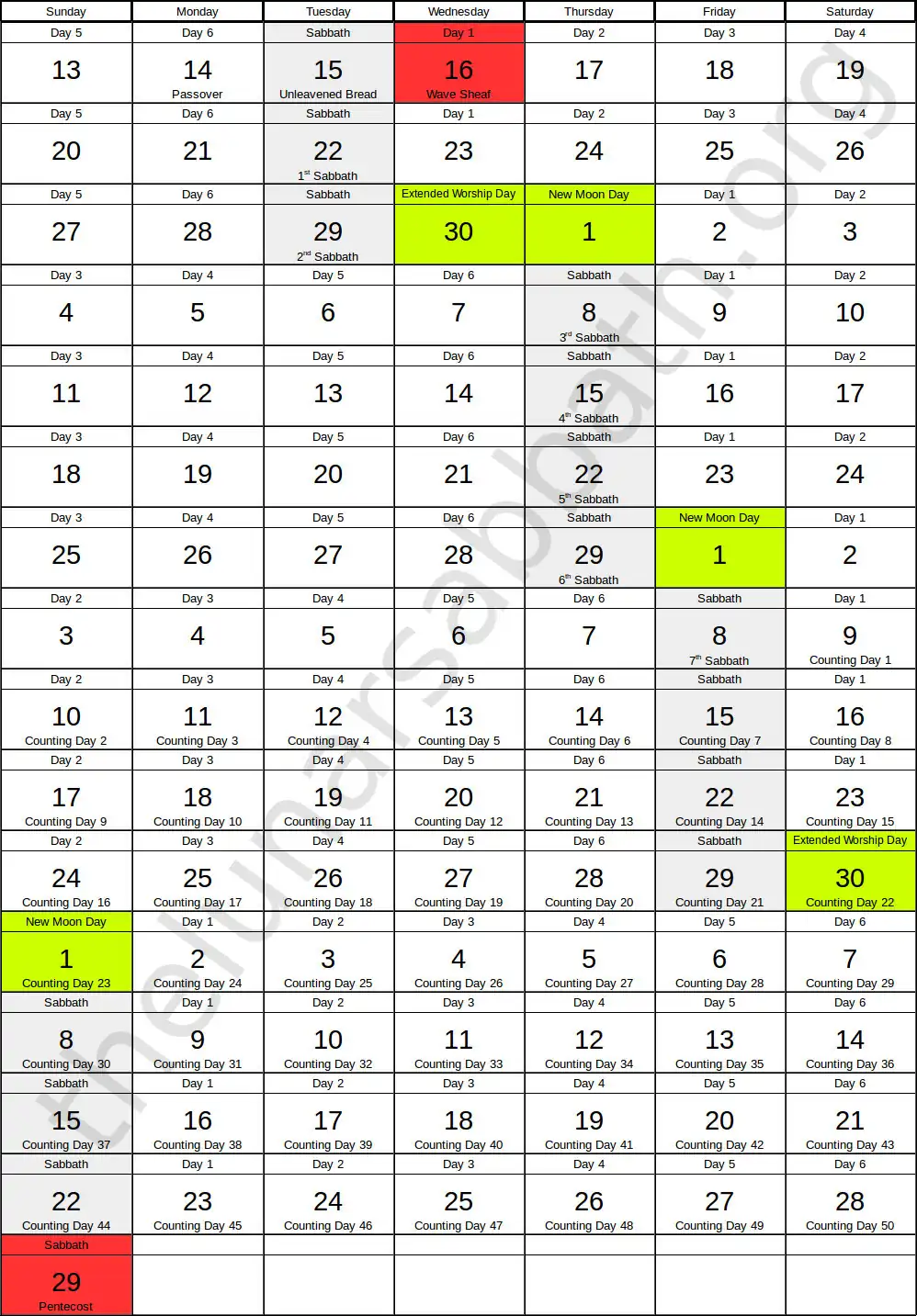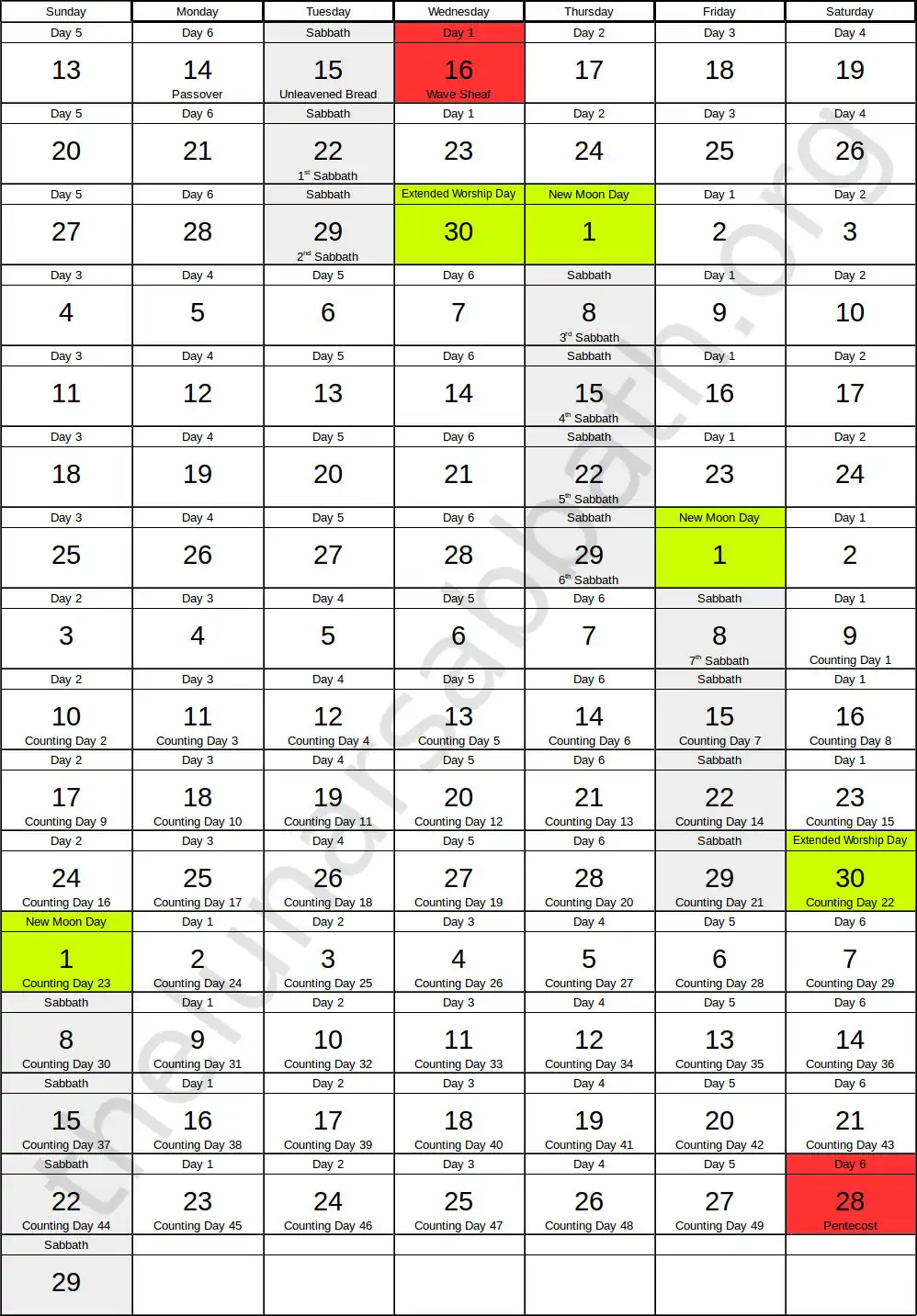Counting of the Omer
The Counting of the Omer is the most distinctive feature of the Lunar Sabbath Pentecost calendar, since it is reckoned differently than all other calendars in use today.
Background
The instructions for the Counting of the Omer are found in Leviticus 23:15-16 :
- And ye shall count unto you from the morrow after the sabbath, from the day that ye brought the sheaf of the wave offering; seven sabbaths shall be complete:
- Even unto the morrow after the seventh sabbath shall ye number fifty days; and ye shall offer a new meat offering unto YHVH.
Traditional Reckoning
The traditional interpretation of Leviticus 23:15-16 is that one should count seven sabbaths from the day after the Sabbath after Passover. This equals fifty days from the day after the first Sabbath to the day after the seventh Sabbath. Therefore verse sixteen can be seen as a clarification of verse fifteen, since you can either count seven weeks plus one day, or fifty days, to arrive at the same date. This interpretation is valid both for the Rabbinic Pentecost calendar, which interprets the "Sabbath" as the First Day of Unleavened Bread, or the Sunday Pentecost calendar which uses the first Sabbath after Passover. However, this interpretation does not work when using the Lunar Sabbath Calendar, because two Sabbaths are not always separated by seven days.
Lunar Sabbath Reckoning
The Counting of the Omer can also be reckoned in a way that aligns with the Lunar Sabbath Calendar. Leviticus 23:15-16 (shown above) can be interpreted as instructions to first count seven Sabbaths and then fifty days. The phrase "even unto” in the KJV can be interpreted as "beginning from", such that that the count of fifty days should begin after the seven Sabbaths are complete. This results in Pentecost being reckoned in the fourth month of the calendar instead of the third.
Sample Calendar
The calendar below shows an example of how the Counting of the Omer is reckoned for Lunar Sabbaths, overlaid on a Gregorian calendar:
Arguments for a Fourth Month Pentecost
Click on the hotlinks below to view the page related to each argument:
- Paul's Third Missionary Journey proves that the count between Passover and Pentecost was more than fifty days
- The Children of Israel kept Pentecost as a “Feast to YHVH” fifty days after the 7th Sabbath
- There are no feasts found in the Bible occurring in the third month, but there is a fourth month feast
- There is no wheat harvest (or harvest of any kind) in the Third month but there is a fourth month wheat harvest
- There are no scriptures citing a wheat harvest in the “spring” instead of “summer”
- The Law was not given to Moses at Sinai until the end of the Fourth month (50 days after the 7th Sabbath)
- There is no “Chag” found in Scripture in the Third month but there is a chag in the fourth month.
- Historical evidence that in the 1st century Pentecost was kept in the fourth month
- Nature proves the 4th month Pentecost
- There was not enough time for the Children of Israel to travel to Mount Sinai for a 3rd month Pentecost
- Acts 1:5 does not disprove a 4th month Pentecost
Common Objections
Deuteronomy 16:9
There is a second place in scripture that describes the Counting of the Omer, and which does not do so as ambiguously as Leviticus 23:
Seven weeks shall thou number unto thee; begin to number the seven weeks from such time as thou beginnest to put the sickle to the corn. And you shall keep the feast of weeks unto YHVH thy God with a tribute of a freewill offering of thine hand, which thou shalt give unto YHVH thy God, according as YHVH thy God hath blessed thee: (Deu 16:9-10)
This passage does not specify seven weeks and then fifty days, it only requires the counting of seven weeks. Therefore a valid interpretation of Leviticus 23:15-16 must refer to counting seven weeks or fifty days, which is not possible on the Lunar Sabbath Calendar.
The definition of "Even Unto"
The phrase "even unto” is an Old English phrase from the King James Version of the Bible that means "even to". That is the opposite meaning of "beginning from", and undermines this method of Counting the Omer. See the page for Even Unto for more information.
Pentecost as a Sabbath
It's clear from Scripture that Pentecost is to be a day of rest:
And ye shall proclaim on the selfsame day, that it may be an holy convocation unto you: ye shall do no servile work therein: it shall be a statute for ever in all your dwellings throughout your generations. (Lev 23:21)
Also in the day of the firstfruits, when ye bring a new meat offering unto YHVH, after your weeks be out, ye shall have an holy convocation; ye shall do no servile work: (Num 28:26)
However, a Lunar Sabbath Pentecost has a 50% chance of falling on the 28th of the month instead of the 29th, and the 28th on the Lunar Sabbath Calendar always falls on the sixth day of the week instead of the seventh. This would mean that the 29th cannot be a weekly Sabbath that month because it is not preceded by six work days. The sample calendar below illustrates this scenario:
Extra-Biblical Sources
The writings of Josephus on Pentecost and Philo on Pentecost provide evidence that neither of these historic figures reckoned the timing of Pentecost by counting seven weeks and then fifty days.

